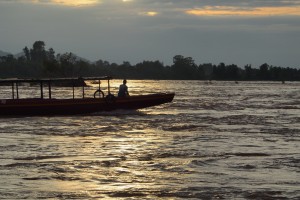The Mekong River Commission (MRC) is still reeling from the blowback over its handling of the consultation process around the Don Sahong and Xayaburi dams in Laos, both of which are expected to have severe environmental consequences on those living downstream.
Now, with its budget slashed—its funding for the next five years is half of what was allocated over the previous period—the commission is preparing to take on another dam on the mainstream Mekong, officials said after a closed-door meeting in Phnom Penh on Wednesday.
Pham Tuan Phan, CEO of the MRC’s secretariat, said the commission had only informally discussed the new dam in Laos—among a number of other issues raised during a meeting with foreign donors on Wednesday.
“We did not formally introduce the Pak Beng dam in the meeting,” Mr. Phan said, explaining that the Chinese company planning the dam, Datang, had yet to begin the consultation procedure, which is meant to include impacted communities.
“But,” he said, “using the lessons learned from Xayaburi, from Don Sahong, we prepared ourselves to consider the process.”
The dam, located in northern Laos, is expected to generate more than three times the power of Don Sahong—912 megawatts, 90 percent of which will be sold to Thailand, according to data from the environmental group International Rivers. It would be the third mainstream Mekong dam outside of China, and would result in the relocation of thousands of people, as well as impact fisheries downstream, the group says.
Meanwhile, grave concerns still linger over the MRC’s handling of Xayaburi and Don Sahong, neither of which has been completed. Save the Mekong Coalition submitted a letter ahead of Wednesday’s meeting saying that the consultation process for both dams was “non-transparent” and “inadequate in ensuring meaningful public participation and input.”
“No plans for further projects on the Mekong River should move forward until outstanding questions and concerns regarding the existing projects…have been fully addressed,” the coalition said.
While the letter was not discussed in the meeting, according to those present, members of the MRC agreed that the environmental impact assessments for both Xayaburi and Don Sahong were insufficient.
So Nam, a fisheries and environmental expert for the commission, said the impacts of both dams on fisheries and the environment were inadequately assessed, and NGOs had little time to air their grievances.
Given that governments were not bound to follow the MRC’s advice, groups advocating for the people and ecosystems reliant on the river were bound to be disappointed when the hydropower dam projects went ahead, Mr. Phan said.
“We may not always meet the expectations of civil society, which are often unrealistic and go beyond our mandate,” he said.
Mr. Phan said the unmet expectations were part of the reason for the drop in donor funding, with the MRC receiving $47 million for the period from 2016 to 2020, down from $115 million for the previous five year period.
“Our development partners feel that—they expect that—the MRC could do more,” he said. “They feel that the MRC should have more authority.”
Source: The Cambodia Daily



